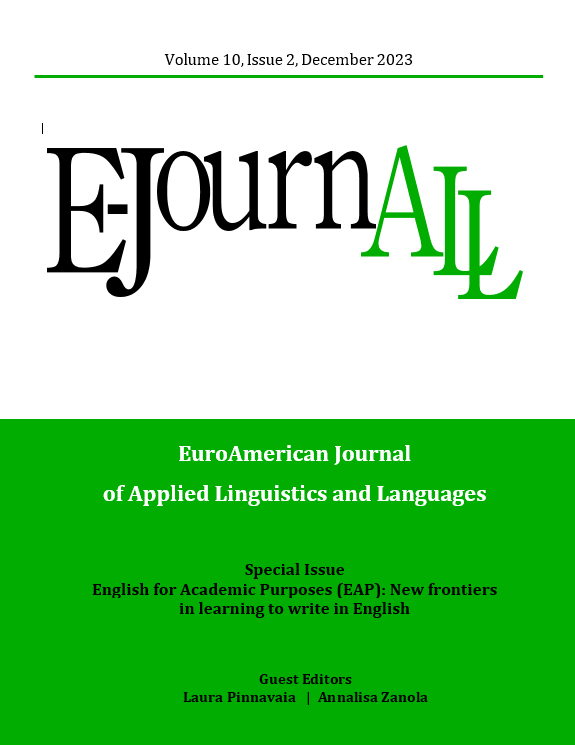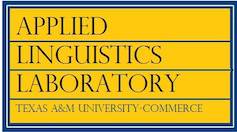EALP textbooks and the challenges of legal English education
DOI:
https://doi.org/10.21283/2376905X.1.10.2.2768Palabras clave:
libros de texto, inglés para fines académicos jurídicos, lenguaje especializado, lenguaje jurídico, educaciónResumen
Durante los últimos treinta años, el inglés para fines académicos (IFA) se ha expandido, abarcando todos los dominios del discurso especializado y ha cambiado su enfoque para satisfacer las necesidades de un gran número de estudiantes de habla no nativa a nivel universitario. En este sentido, el inglés para fines académicos jurídicos (IFAJ) puede definirse como la enseñanza y el aprendizaje del inglés jurídico como un área del inglés para fines específicos (IFE) que incluye las dimensiones académicas del IFA. Este artículo investiga cómo los libros de texto de IFA han respondido a los desafíos de la educación en la facultad de derecho. Reflexionando sobre las contribuciones pedagógicas de Carrick y Dunn (1985), Candlin, Bhatia y Jensen (2002), y Prinsloo (2015), este artículo comienza diacrónicamente con una muestra de libros de texto de tipo IFAJ a partir del momento en que Prinsloo completó su análisis. Partiendo de estas revisiones, este artículo intenta proporcionar algunas ideas sobre el desarrollo de libros de texto de tipo IFAJ y sobre su respuesta a los desafíos de la educación jurídica en inglés.
Citas
Alqahtani, Amjed (2011). An investigation into the language needs of Saudi students studying in British Postgraduate programmes and the cultural differences impacting on them. Thesis for the degree of Doctor of Philosophy. University of Southampton. Retrieved from Binder1.pdf (soton.ac.uk).
Anthony, Laurence (2018). Introducing language for specific purposes. Routledge.
Balcom, Patsy & Kozar, Seana (1994). An ESP speaking course for international graduate students. TESL Canada Journal, 12(1), 58–68.
Benaquisto, Lucia (2008). Axial coding. In Lisa M. Given (Ed.). The SAGE Encyclopedia ofQualitative Research Methods (pp. 51-52). SAGE.
Belcher, Diane (2009). English for specific purposes in theory and practice. University of Michigan Press ELT.
Bhatia, Vijay K. (1989). Legislative writing: A case of neglect in EA/OLP courses. English for Specific Purposes 8, 223-238. https://doi.org/10.1016/0889-4906(89)90014-8
Bhatia, Vijay K. (1993). Analysing genre: language use in professional settings. Longman.
Bhatia, Vijay K. (2008). Genre analysis, ESP and professional practice. English for Specific Purposes 27, 161-174. https://doi.org/10.1016/j.esp.2007.07.005
Candlin Christopher, Bhatia, Vijay K., & Jensen, Christian H. (2002). Developing legal writing materials for English second language learners: problems and perspectives. English for Specific Purposes 21(4), 299-320. https://doi.org/10.1016/S0889-4906(01)00029-1
Carrick, Kathleen & Dunn, Donald J. (1985). Legal writing: an evaluation of the textbook literature. New York Law School Law Review 30, 645-675.
Coffey, Bernard (1984). ESP – English for specific purposes. Language Teaching 17, 2-16. https://doi.org/10.1017/S0261444800010405
Creswell, John D. (2014). Research design: qualitative, quantitative, and mixed methods approaches. SAGE publications.
Danet, Brenda (1980). Language in the legal process. Law & Society Review 14(3), 445-564. https://doi.org/10.2307/3053192
Dolin, Jason M. (2007). Opportunity lost: how law school disappoints law students, the public, and the legal profession. California Western Law Review 44, 219-255. Available at: https://scholarlycommons.law.cwsl.edu/cwlr/vol44/iss1/6
Dörnyei, Zoltán (2007). Research methods in applied linguistics. Oxford University Press.
Douglas, Heather (2022). Sampling techniques for qualitative research. In Islam M. Rezaul, Ahmed Khan Niaz & Baikady Rajendra (Eds.). Principles of Research Methodology (pp. 415-426). Springer.
Dudley-Evans, Tony, & St John, Maggie J. (1998). Developments in English for specific purposes: a multi-disciplinary approach. Cambridge University Press.
Eldeman, Diane (2010). Making a case for legal writing instruction worldwide. Jurisprudencija/Jurisprudence 1(119), 111-123.
Flowerdew, John (2016). English for specific academic purposes (ESAP) writing: making the case. Writing & Pedagogy 8(1), 5-32. https://doi.org/10.1558/wap.v8i1.30051
Flowerdew John, & Peacock, Matthew (2001). Research perspectives on English for academic purposes. Cambridge University Press.
Gerkman, Alli, & Cornett, Logan (2017). Foundations for practice: the whole lawyer and the character quotient. IAALS, the Institute for the Advancement of the American Legal System, 1-41.
Gibbons, John (1999). Language and the law. In Alan Davies & Catherine Elder (Eds.). The handbook of applied linguistics (pp. 286-303). Blackwell Publishing.
Gibbons, John P. (2014). Language and the law. Routledge.
Graves, Kathleen (2000). Designing language courses. A guide for teachers. Heinle & Heinle.
Halliday, Michael A.K. (1993). Towards a language-based theory of learning. Linguistics and Education 5, 93-116. https://doi.org/10.1016/0898-5898(93)90026-7
Halliday, Michael A.K. (2006). Linguistic studies of text and discourse (Vol. 2). A&C Black.
Hess, Gerald F. (2002). Heads and hearts: the teaching and learning environment in Law School. Journal of Legal Education 52, 75-111. https://www.jstor.org/stable/42893745
Hyland, Ken (2006). English for academic purposes: an advanced resource book. Routledge.
Hyland, Ken (2009). Academic discourse. Continuum.
Hyland, Ken & Hamp-Lyons, Liz (2002). EAP: issues and directions. Journal of English for Academic Purposes 1(1), 1-12. https://doi.org/10.1016/S1475-1585(02)00002-4
Johns, Ann M. (1997). Text, role and context: developing academic literacies. Cambridge University Press.
Johns, Ann M. (2013). The history of English for specific purposes research. In Brian Paltridge & Sue Starfield (Eds.). The handbook of English for specific purposes (pp. 5-30). Wiley-Blackwell.
Johnson, Nick (2020). The clinical legal education handbook. University of London Press.
Kennedy, Duncan (2004). Legal education and the reproduction of hierarchy: a polemic against the system. New York University Press.
Lichtman, Marilyn (2013). Qualitative research in education: A user’s guide. SAGE publications.
Linden, Thomas & Johnson, Nick (2020). The clinical legal education handbook. University of London Press.
Prinsloo, Christian (2015). English for academic legal purposes: textbook typologies that inform legal English pedagogy. International Journal of Legal English 3(1), 4-27.
Shahab, Sara, Nasser, Rashidi, Firooz, Sadighi & Mortaza, Yamini (2020). A textual discourse analysis of introductions in textbooks of humanities and basic sciences. Canadian Journal of Applied Linguistics 23, 137-168. https://doi.org/10.37213/cjal.2020.28750
Shenton, Andrew K. (2004). Strategies for ensuring trustworthiness in qualitative research projects. Education for Information 22, 63–75.
Sullivan, William M., Colby, Anne, Wegner, Judith W., Bond, Lloyd & Shulman, Lee L. (2007). Educating lawyers. Preparation of the profession of law. John Wiley & Sons.
Stuckey, Roy T. (2007). Best practices for legal education. Carolina (US): Clinical Legal Education Association.
Swales, John (2004). Research genres: explorations and applications. Cambridge University Press.
Teddlie, Charles & Yu, Fen (2007). Mixed method sampling: a typology with examples. Journal of Mixed Methods Research 1(7), 77-100. https://doi.org/10.1177/1558689806292430
Tiersma, Peter (2006). Some myths about legal language. Law, Culture and the Humanities 2, 29-50.
Trask, Robert L. (2007). Language and linguistics: the key concepts. Routledge.
Venturi, Giulia (2010). Legal language and legal knowledge management applications. In Enrico Francesconi, Simonetta Montemagni, Wim Peters & Daniela Tiscornia (Eds.) Semantic processing of legal texts: where the language of law meets the law of language (pp. 3-26). Springer-Verlag.
Williams, Christopher (2014). The future of ESP studies: building on success, exploring new paths, avoiding pitfalls. ASp 66. Retrieved from http://journals.openedition.org/asp/4616.
Descargas
Publicado
Cómo citar
Número
Sección
Categorías
Licencia
Derechos de autor 2023 Giulia Adriana Pennisi

Esta obra está bajo una licencia internacional Creative Commons Atribución 4.0.


